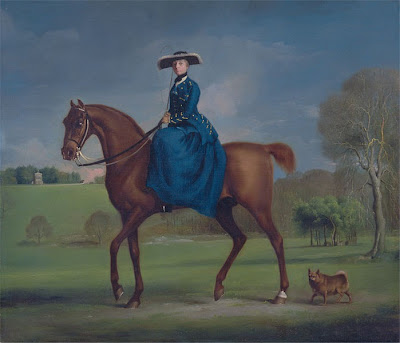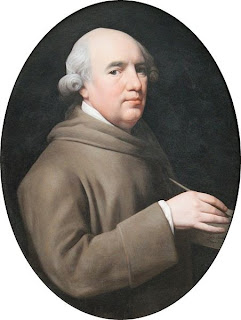While I recover from the decadence of my birthday celebrations, let's leave matriarchs and kings behind in favour of another artist and enjoy a pastoral interlude in the company of George Stubbs.
Little is known of the early years of George Stubbs and though his peer, Ozias Humphry, set down a few notes about his fellow artist's younger years they are brief and their veracity unconfirmed. Still, they're all we have to go on - even grandmother Gilflurt didn't know this young man!
Stubbs was born to a Liverpool currier and leather merchant and took up the same trade, joining his father's business and remaining there until the death of Stubbs senior in 1741. Suddenly free to indulge his artistic ambitions, the young man travelled to Lancashire where he served as an apprentice to a local artist named Hamlet Winstanley. Hoping to learn more of his craft, Stubbs was disappointed to find himself given the task of copying works, with little room for self-expression. Rather than remain in the role of apprentice Stubbs struck out on his own, travelling northern England working as a portrait painter.
 |
| Portrait of Isabella Saltonstall, 1765 |
Building his reputation little by little, Stubbs continued to paint as he took up a studentship at York County Hospital, where he studied human anatomy. He left the Hospital in 1751, the same year in which he was commissioned to illustrate a midwifery manual. By now more than proficient in his chosen craft, the young man decided the time was right to broaden his horizons a little. In search of further inspiration he toured Italy before returning home to England where he set up home in Lincolnshire with Mary Spencer.
His early career and anatomical studies left Stubbs with a fascination for equine studies and he now devoted himself to this subject, dissecting horses and learning all he could of their anatomy. With Mary at his side he finally arrived in London in 1759 where, seven years later, he put his learning to use in the publication of the seminal work, The Anatomy of the Horse. Thanks to his extraordinary artistic work in the equine field Stubbs became a favourite of the upper classes and when the Charles Lennox, Duke of Richmond, commissioned a number of pieces from Stubbs, his future was guaranteed. The Duke was just one of many ennobled patrons and Stubbs was soon secure in both finance and reputation, the man to go to for sporting pictures.
 |
| Whistlejacket, 1762 |
Initially a keen exhibitor at the Society of Artists, Stubbs specialised not only in depicting horses but also their grooms, whom he would paint alongside the animal in their care. Though he still worked on portraits throughout his career it was for his equine works that he became famous, eventually exhibiting at the Royal Academy in 1775. However, his status as a sporting painter meant he was ineligible for full membership of the Academy.
 |
| The Countess of Coningsby in the Costume of the Charlton Hunt, 1765 |
Branching out into printmaking and engraving, Stubbs finally made an uncharacteristically poor decision when he invested a large amount of money into a new scheme of painting on enamel. The expensive enterprise failed and Stubbs was left in debt, a situation he remedied by swiftly returning to his more familiar works.
 |
| A Grey Hunter with a Groom and a Greyhound at Creswell Crags, 1762 |
As he grew older the artist's list of patrons grew ever more illustrious and the Prince of Wales was a particular fan. At the time of his death, the 81 year old Stubbs was already working on another painting, an anatomical study that he left unfinished. His works are both highly detailed but also invested with a sense of beauty, perfectly capturing the character of each horse as other artists might capture a human portrait subject. He remains arguably the greatest equine painter the country has ever produced, his works in high demand when they appear on sale.
If that's whetted your appetite for Stubbs, you can see more here and here!

4 comments:
Just shows what focus can do for you! Imagine having that much interest and dedication to learn about anatomy by dissecting horses - just so you could paint them! Wonderful artwork!
His equine paintings are remarkable, if you get the chance to see them up close, take it!
I love his paintings. Thanks.
Thank you for stopping by!
Post a Comment